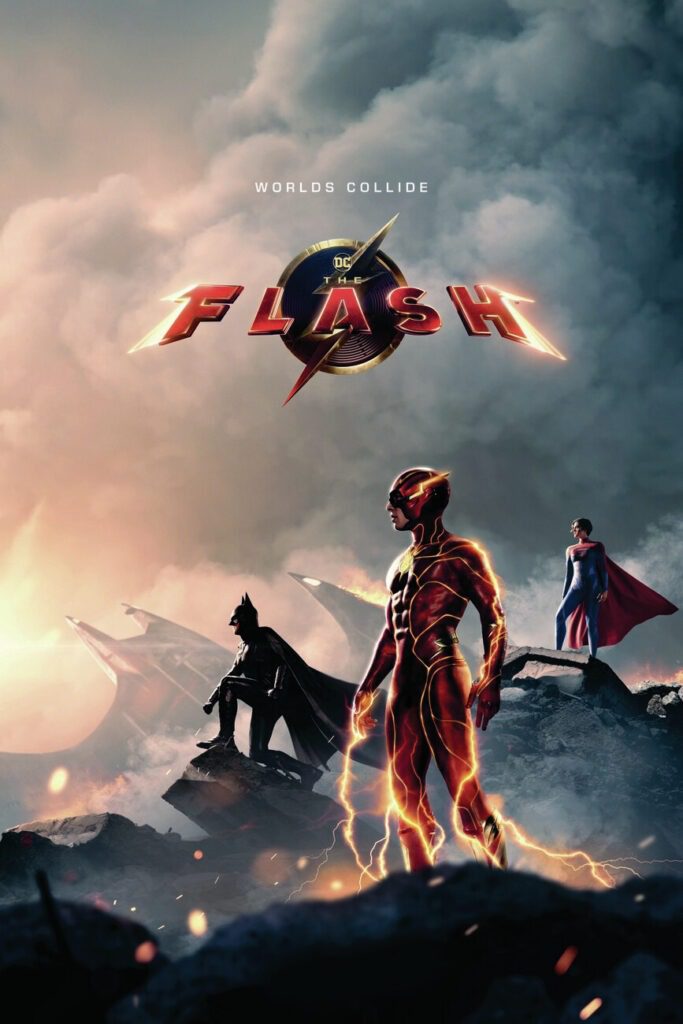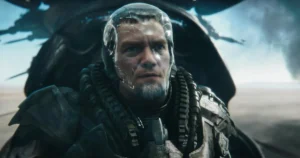The Flash Review: A Speedy Adventure with Mixed Results
The Flash presents a whirlwind of visual highs and narrative lows, weaving a complex tale of time, identity, and heroism. Its ambitious journey delivers moments of brilliance, yet stumbles in fully realizing its vast potential, offering an intriguing but uneven cinematic experience.
Written By Sam Burley · June 15, 2023
0 Comments

The Flash: A Turbulent Journey Through Time and Superheroism
“The Flash,” the long-anticipated standalone film featuring one of DC’s most iconic characters, finally makes its debut, presenting a tale that oscillates between the heights of visual spectacle and the valleys of narrative inconsistency. Directed by Andy Muschietti and written by Christina Hodson, this cinematic endeavor embarks on a journey filled with time travel, emotional depth, and a touch of superhero chaos.
Visual Mastery and Missteps

The film is a patchwork of stunning digital effects and less convincing CGI moments. On one hand, it showcases some of the most impressive visual feats in recent superhero cinema, crafting scenes that are both captivating and immersive. On the other hand, these moments are interspersed with segments where the CGI fails to hit the mark, leading to a disjointed visual experience that can detract from the film’s overall impact.
The varying quality of CGI in “The Flash” raises questions about the use of digital effects in storytelling. In moments where the CGI excels, it enhances the narrative, adding a layer of spectacle to Barry’s super-speed abilities and the film’s action sequences. However, when the effects fall short, they become a distraction, pulling the viewer out of the story and highlighting the challenges of relying heavily on digital technology in filmmaking.
Ultimately, the inconsistency in “The Flash” not only affects the film’s aesthetic appeal but also impacts its emotional resonance. Key moments intended to deliver emotional depth or pivotal plot developments are occasionally undermined by less convincing CGI environments, detracting from the film’s ability to fully engage its audience.
Narrative Pace: Racing Through Time
“The Flash,” drawing heavy inspiration from the Flashpoint comic book arc, thrusts Barry Allen, portrayed by Ezra Miller, into a vortex of time-altering decisions in the aftermath of “Justice League.” The narrative ambitiously navigates the intricacies of a multiversal saga, maintaining an admirably rapid pace that mirrors the titular character’s super-speed abilities. This brisk pacing aligns well with the film’s central theme of time manipulation, as Barry grapples with the consequences of his actions across different timelines.
However, the film’s swift narrative progression occasionally sacrifices depth for speed. Key plot points, pivotal to the understanding and emotional resonance of the story, seem rushed or inadequately explored. For instance, Barry’s journey across alternate realities presents a wealth of opportunities for character development and exploration of complex themes. Yet, these moments are sometimes glossed over, leaving the audience craving more substance and clarity.
The relationships between characters, a crucial element of any character-driven story, also suffer from this expedited storytelling. While the film introduces intriguing dynamics, such as Barry’s interactions with alternate versions of himself and other iconic DC characters, these relationships often lack the screen time needed to fully develop. As a result, emotional connections that could have added layers of depth to the narrative feel somewhat superficial or undercooked.
Moreover, the film’s adherence to a rapid pace leads to missed opportunities in fleshing out its multiverse concept. The exploration of alternate realities, a concept rich with potential for creative storytelling, is not as expansive or as detailed as it could have been. In essence, while “The Flash” impresses with its ability to keep the story moving at a breakneck speed, it overlooks the importance of slowing down at key moments to allow for a more thorough exploration of its characters and the profound implications of its central plot device. This narrative pacing, while fitting for a film about the fastest man alive, ultimately detracts from the potential depth and complexity of the story.
The Guest Stars: Keaton and Calle

Michael Keaton‘s highly anticipated return as Batman and Sasha Calle‘s impressive debut as Supergirl stand out as significant highlights in “The Flash.” Keaton’s reprisal of his iconic role brings more than just a sense of nostalgia; it adds a layer of depth and gravitas to the film. His portrayal of Batman is not merely a trip down memory lane for fans of the original Batman films. It is a reimagining of a beloved character, seamlessly fitting into the modern narrative while preserving the essence that made his portrayal legendary. Keaton’s Batman is a bridge between past and present, offering a nuanced performance that balances the darkness and complexity of the character with the evolved context of “The Flash.”
Sasha Calle’s introduction as Supergirl marks a refreshing addition to the DC Universe. Her portrayal breathes life into a character that has been eagerly awaited by fans. Calle’s Supergirl is not just a female counterpart to her famous cousin; she is depicted as a formidable hero in her own right. Her performance exudes strength and vulnerability, bringing a new dimension to the character that challenges traditional perceptions. Calle’s chemistry with the rest of the cast, especially Ezra Miller’s Flash, adds dynamism to the ensemble, infusing it with a new energy that enriches the film’s narrative tapestry.
The inclusion of these characters does more than just bolster the film’s star power; it creates a unique blend of legacy and innovation. Keaton’s Batman provides a link to the superhero genre’s cinematic past, while Calle’s Supergirl represents the future potential of the DC Universe. This juxtaposition of the old guard and the new blood serves as a narrative catalyst, driving the story forward and enhancing the film’s appeal across different generations of viewers.
Furthermore, their roles in the film are not mere cameos but are integral to the storyline. Keaton’s Batman serves as a mentor and a guiding force, helping to steer Barry through his tumultuous journey. Meanwhile, Calle’s Supergirl adds an essential layer to the film’s exploration of heroism and identity. Her portrayal brings a sense of earnestness and sincerity, making her character more than just a symbol of power; she becomes a relatable figure that audiences can connect with.
In “The Flash,” Keaton and Calle’s performances are pivotal, offering more than just fan service. They enrich the narrative, bringing a blend of experienced wisdom and youthful vigor that elevates the film. Their presence adds depth and complexity to the story, making their characters memorable and significant in the expanding tapestry of the DC cinematic universe.
A Tale of Two Barry’s

“The Flash” introduces an intriguing narrative element by featuring two versions of Barry Allen, each portrayed by Ezra Miller. This dual portrayal offers a unique exploration of the character’s evolution and the complexities of his superhero identity. The presence of two Barrys creates a dynamic interplay, allowing the film to delve into themes of self-reflection, identity, and the consequences of one’s actions.
This dual perspective is more than a narrative gimmick; it serves as a critical element of the film’s exploration of heroism and responsibility. The interactions between the two Barrys highlight the nuances of Barry Allen’s character, showcasing his growth from a hesitant hero to a more confident and self-aware individual. This internal dialogue played out between the two versions, enriches the narrative and adds depth to the character’s journey.
The portrayal of two Barrys also allows the film to examine the idea of alternate choices and paths. Through these characters, “The Flash” explores the concept of what it means to be a hero and the different forms this can take. The film uses this duality to present a more complex and layered view of heroism, one that is not just about superpowers but also about personal growth and the impact of decisions.
The dynamic between the two Barrys injects a sense of humor and levity into the film. Their interactions provide moments of comic relief and lightheartedness, balancing the more serious and dramatic elements of the story. This balance enhances the film’s entertainment value and makes the narrative more engaging for the audience.
The Role of Antagonists and Conflict

“The Flash” distinguishes itself within the superhero genre by adopting an unconventional approach to its antagonists and conflict. Instead of relying heavily on external villains, the film emphasizes Barry Allen’s internal dilemmas and the ethical implications of his time-altering abilities. This narrative choice allows for a deeper exploration of Barry’s character, shifting the focus from physical confrontations to emotional and moral challenges.
While traditional adversaries, such as General Zod, are present, their roles are more peripheral, serving to complement rather than dominate the storyline. This subtler use of antagonists enriches the plot, steering the film away from typical superhero tropes and towards a more introspective journey. The film navigates Barry’s personal growth and self-discovery, resonating with audiences through its portrayal of relatable conflicts and decisions.
This nuanced approach to conflict in “The Flash” not only adds complexity to Barry’s character but also offers a refreshing change in a genre often characterized by predictable patterns of hero versus villain dynamics. By focusing on the ramifications of Barry’s actions across timelines, the film presents a thought-provoking narrative that delves into themes of responsibility and the consequences of one’s choices.
In summary, “The Flash” redefines the role of antagonists in superhero storytelling. The film’s emphasis on internal struggles over external battles contributes to a more character-driven and emotionally engaging narrative, setting it apart in the superhero film landscape.
A Speedster’s Mixed Legacy
In summary, “The Flash” presents a mixed bag in the realm of superhero cinema. While it shines with some impressive visual effects and introduces compelling concepts through the Flashpoint story arc, the film is hampered by uneven CGI and a hurried narrative that skims over deeper character exploration. The dual portrayal of Barry Allen by Ezra Miller adds a unique twist, but the rapid pace of the story leaves little room for these elements to fully resonate. Guest appearances by Michael Keaton and Sasha Calle add nostalgia and excitement but are not enough to offset the film’s overall inconsistencies.
Though “The Flash” takes an innovative approach by focusing on internal conflict over traditional villain-centric plots, this aspect could have been more impactful with better narrative development. Ultimately, while “The Flash” offers moments of entertainment and intrigue, it falls short of being a standout addition to the superhero genre, providing a satisfactory but not exceptional cinematic experience.
